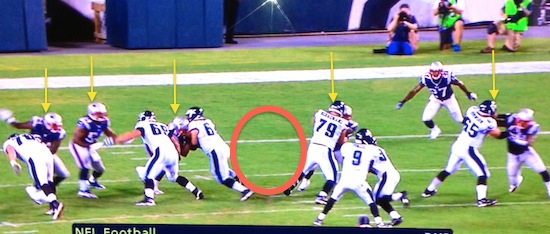No-22: What We Saw From Chip Kelly’s Offense
Chip Kelly said after Friday’s game that his up-tempo package is just one of many tools in his toolbox.
The truth is, it’s likely to become the foundation of his offense. It’s what Kelly had so much success with at Oregon. It’s what the Eagles have been practicing all offseason long. And it’s a style that other NFL teams are already having success with.
But as we saw Friday night, there’s more to it than just tempo.
Last August, Chris Brown of Grantland wrote about the concept of “packaged plays.” The idea is to give the offense multiple options on any given play, while allowing the quarterback to decide where to go with the football:
The rise of “packaged plays” is important on its own, but it becomes essential when combined with the other trend in football — the up-tempo no-huddle. The no-huddle, especially when operated by quarterbacks like Rodgers or Tom Brady, is an invaluable weapon when combating modern defenses that rely on constant movement to maximize confusion. “In the no-huddle context, the advantage of packaged plays becomes particularly acute,” says Grabowski, adding, “An offense that can run these packaged plays at the fastest tempos can get a vanilla look that further simplifies the read on a key defender.” If you’re going to go fast-paced no-huddle to prevent defenses from substituting or setting up in something exotic, you have to do it, well, fast, and slow audibles with lots of words and gyrations at the line are not that.
Brown will be writing about Kelly and the Eagles in the coming days, but it sure looked like the offense was doing just what he described above.
All offseason, the Eagles’ offensive players have talked about how the new scheme gives them many options. When Nick Foles got into the game, we got a glimpse of what they’ve been talking about.
Unfortunately, there’s no All-22 available for preseason games, but here are some shots off the TV tape.
The pre-snap look on first down:
The Eagles are in 12 personnel with one running back, two tight ends and two wide receivers. They have a stacked look to both sides, with Brent Celek and Zach Ertz in front of DeSean Jackson and Riley Cooper. Bryce Brown is in the backfield.
Take a look at what happens when Foles goes to hand the ball off to Brown:
It looks like Foles has four different options on this play, depending on how the defense lines up. He can hand the ball to Brown. But he also has screens set up to both sides, which the defense has to account for.
The fourth option?
Foles can keep the ball and run. All summer long, I’ll admit I’ve poked fun at this as a possibility. But look at how Foles carries out the fake, starting to run to the left. Brown clearly has the ball at this point, but right defensive end Chandler Jones is looking at Foles in the backfield.
That allows Brown to find a lane and pick up 8 yards.
We saw similar concepts during the 10-play, 62-yard touchdown drive in the second. This looks like a zone read with an unblocked defender. Foles can hand the ball off, keep it and run or go to a screen on the perimeter to either side.
And finally, the 8-yard Brown touchdown run. This one comes down to basic math. Take a look pre-snap. The Patriots only have five defenders in the box.
The Eagles have a numbers advantage. Again, you’ll see WR screens set up on the perimeter.
The Patriots keep six defenders on the perimeter. That means the offensive line gets “hat-on-hat” blocks up front. Left tackle Allen Barbre struggles with his guy, but everyone else does their job, creating a lane that any back in the league would be able to run through. Todd Herremans and Jason Kelce, specifically, do a great job.
This is a bit of a guess on my part, but the safety (No. 27) probably could have cheated up, if not for the threat of the screen to his side. By the time he makes his way over to Brown, it’s too late. He’s already in the end zone.
The Eagles went no-huddle, up-tempo for the entire drive. And they only changed personnel once (after the first two plays). The game clock stopped on one incompletion. Taking that play out of the equation, on average, only 18 seconds came off the game clock in between snaps.
We’ll have more after reviewing the game, but these are some of the concepts that stood out the first time around.
Follow Sheil Kapadia on Twitter and e-mail him at skapadia@phillymag.com.
Become a fan of Birds 24/7 on Facebook.
